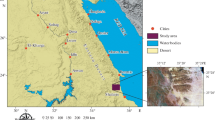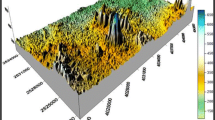Abstract
Gabal Hamret Mukbud and Gabal Homr Akarim granites represent promising examples for rare-metal enriched peraluminous granite hosting or acting as source for the uranium, rare-metal (Nb, Ta, Th, Be, Yb) mineralization and rare-earth (La, Ce, Lu, Y) contents in the south Eastern Desert of Egypt. They form two famous plutons crop out at wadi Khasab area. These granites show a strong enrichment in some rare-metal and rare-earth contents (Nb = 75.22, Y = 168.5, Th = 29.70, U = 15.58, Ta = 106.3, Be = 191.80, Yb = 33.01, Lu = 5.19, La = 139, Ce = 55.98 ppm). These granites are classified as peraluminous leucogranites (A/CNK = 1.38–2.01), P-poor (P2O5 < 0.001 wt%), and Na2O rich (<5.01 wt%). Field studies indicate that these granites are categorized into fine, medium, and coarse grained. Petrographic studies indicate that these granites are composed essentially of microcline-perthite, perthite, albite plagioclase, quartz, biotite, and muscovite. Zircon, fluorite, sphene, and apatite are the main accessory minerals in these granites. Also, these studies confirmed the presence of radioelements in the form of secondary radioactive minerals such as uranophane and their uranium-bearing minerals such as metamict zircon and violet fluorite, suggesting that the radioactivity of Gabal Hamret Mukbud and Gabal Homr Akarim granites is gained by the post-magmatic processes and hydrothermal solutions. Petrochemical studies and tectonic discrimination diagrams for these granites reveal that they are ranging in composition from granite to admelite, have peraluminous affinity and developed in post-orogenic granitoids. Albitization, silicification, and greisenization are the prevailing alteration processes in these granites. Field radiometric measurements for both Gabal Hamret Mukbud and Gabal Homr Akarim granite revealed that uranium and thorium as secondary minerals and also the in resistant accessory minerals represent by metamict zircon and fluorite mineral. Radioactivity level reached up to 12.5 ppm (eU) at Gabal Hamret Mukbud granite, while it reaches up to 21.8 ppm (eU) at Gabal Homr Akarim granite.




















Similar content being viewed by others
References
Ali K, Moghazi A, Maurice A, Omar S, Wang Q, Wilde S, Moussa E, Manton W, Stern R (2012) Composition, age, and origin of the ~620 Ma Humr Akarim and Humrat Mukbid A-type granites: no evidence for pre-Neoproterozoic basement in the Eastern Desert, Egypt. International Journal of Earth Sciences, 101(7):1705–1722
Basham IR, Varinho MMB, Bowles JFW (1982) Uranium bearing accessory minerals in the Sao Pedro do Sul granite, Portugal. In Vein type and similar uranium deposits in rocks younger than Proterozoic. Proc. Tech. Comm. IAEA meeting, Lisbon, pp. 279–297
Cathelineau M (1986) The hydrothermal alkali metasomatism effects on granitic rocks: quartz dissolution and related subsolidus change. J Petrol 27:945–965
Cuney M and Friedrich M (1987) Physicochemical and crystal-chemical controls on accessory mineral paragenesis in granitoids. Implications on uranium metallogenesis; Bulletin de Minéralogie, 110:235–247
Debon F, Le Fort P (1983) Chemical-mineralogical classification of plutomc rocks and associations-example from southern Asia belts. In: Xu K, Tu G (eds) Geology of granites and their metallogenetic relations. Science, Beijing, pp 293–311, Equally in Chinese
El Ramly MF, Hilmy ME, Ali MM, Hassan OA (1982) Petrological and petrochemical studies on some young granitic masses in the south Eastern Desert of Egypt. Ann Geol Surv Egypt 12:73–102
Friedrich M (1984) Le complexe granitique hyperalumineux de Saint Sylvestre, NW du Massif Central francais: Geol Geochim. Uranium, Mem., Nancy, Vol. 5
Friedrich M, Cuney M, Poty B (1987) Uramum geochemistry in peraluminous Ieucogranites. Uranium 3:353–385
Govindaraju K, Mevelle C, Chouard C (1976) Automated optical emission spectrochemical bulk analysis of silicate rocks with microwave plasma excitation. Anal Chem 48:1325–1331
Henderson P (1996) Rare earth elements, introduction and review. In: Jones AP, Wall F, Williams CT (eds) Rare earth minerals: chemistry, origin and deposits. The Mineralogical Society Series, pp 1–19
Maniar PD, Piccoli PM (1989) Tectonic discrimination of granitoids. Geol Soc Am Bull 101:635–643
Niazy EA, Shalaby IM, Diab MB (1985) Sulphide-silicate mineral interrelations of Gabbro Akarem Ni-Cu mineralization, Eastern Desert, Egypt, Annals of the Geological survey of Egypt, V. XV, pp. 211–221
Pagel M (1981) Acteurs de distribution et de concentration de l’uranium et du Thorium dans quelques granities de Ia chaine hercynienne D’Europe. Thesis, Univ. of Nancy 1, L in Leroy and Turpin, 1988
Pearce J A, Harris NB and Tindle AG (1984) Trace element discrimination diagrams for the tectonic interpretation of granitic rocks, J Petrol 25:956–984
Ranchin G (1971) La geochimie de l’uranium et la differenciation granitique dans la province uranifere du Nord Limousin. Sci Terre Mem Nancy 19:394
Rashwan AA, Abd El Ghaffar H, Meky AM, Zahran S, Tharout AK, Abdel El Kader O, Bishara AN (1978) Geology of Humret Mikbid, south Eastern Desert, Egypt, Internal Report 68/1978, The Egyptian Geological Survey and Mining Authority, 31 p
Rasmy AH (1982) Mineralogy of the copper-nickel mineralization, Akarem Area, south Eastern Desert, Egypt. Ann Geol. Survey, Egypt
Yonan AA (1996) REEs fractionation in colored hydrothermal vein type fluorites associated with others ore-deposits from Eastern Desert of Egypt. Proc Geol Surv Egypt Cenn Conf, pp. 821–836
Author information
Authors and Affiliations
Corresponding author
Rights and permissions
About this article
Cite this article
Masoud, M.S., Shahin, H.A.A. Rare-metal enriched peraluminous granite: examples from south Eastern Desert, Egypt. Arab J Geosci 8, 1299–1314 (2015). https://doi.org/10.1007/s12517-014-1296-z
Received:
Accepted:
Published:
Issue Date:
DOI: https://doi.org/10.1007/s12517-014-1296-z




